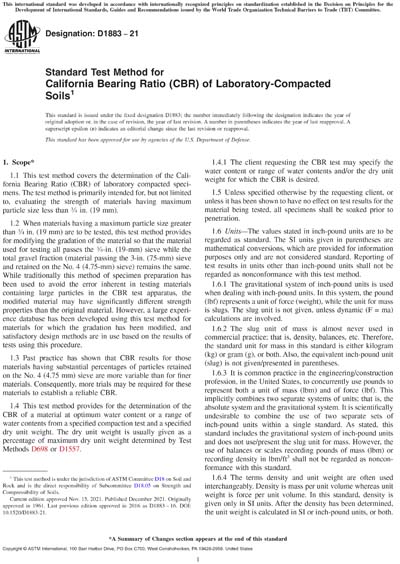Most recent
ASTM D1883-21
Standard Test Method for California Bearing Ratio (CBR) of Laboratory-Compacted Soils
1.1This test method covers the determination of the California Bearing Ratio (CBR) of laboratory compacted specimens. The test method is primarily intended for, but not limited to, evaluating the strength of materials having maximum particle size less than 3/4in. (19 mm).
1.2When materials having a maximum particle size greater than 3/4in. (19 mm) are to be tested, this test method provides for modifying the gradation of the material so that the material used for testing all passes the 3/4-in. (19-mm) sieve while the total gravel fraction (material passing the 3-in. (75-mm) sieve and retained on the No. 4 (4.75-mm) sieve) remains the same. While traditionally this method of specimen preparation has been used to avoid the error inherent in testing materials containing large particles in the CBR test apparatus, the modified material may have significantly different strength properties than the original material. However, a large experience database has been developed using this test method for materials for which the gradation has been modified, and satisfactory design methods are in use based on the results of tests using this procedure.
1.3Past practice has shown that CBR results for those materials having substantial percentages of particles retained on the No. 4 (4.75 mm) sieve are more variable than for finer materials. Consequently, more trials may be required for these materials to establish a reliable CBR.
1.4This test method provides for the determination of the CBR of a material at optimum water content or a range of water contents from a specified compaction test and a specified dry unit weight. The dry unit weight is usually given as a percentage of maximum dry unit weight determined by Test Methods D698 or D1557.
1.4.1The client requesting the CBR test may specify the water content or range of water contents and/or the dry unit weight for which the CBR is desired.
1.5Unless specified otherwise by the requesting client, or unless it has been shown to have no effect on test results for the material being tested, all specimens shall be soaked prior to penetration.
1.6Units - The values stated in inch-pound units are to be regarded as standard. The SI units given in parentheses are mathematical conversions, which are provided for information purposes only and are not considered standard. Reporting of test results in units other than inch-pound units shall not be regarded as nonconformance with this test method.
1.6.1The gravitational system of inch-pound units is used when dealing with inch-pound units. In this system, the pound (lbf) represents a unit of force (weight), while the unit for mass is slugs. The slug unit is not given, unless dynamic (F = ma) calculations are involved.
1.6.2The slug unit of mass is almost never used in commercial practice; that is, density, balances, etc. Therefore, the standard unit for mass in this standard is either kilogram (kg) or gram (g), or both. Also, the equivalent inch-pound unit (slug) is not given/presented in parentheses.
1.6.3It is common practice in the engineering/construction profession, in the United States, to concurrently use pounds to represent both a unit of mass (lbm) and of force (lbf). This implicitly combines two separate systems of units; that is, the absolute system and the gravitational system. It is scientifically undesirable to combine the use of two separate sets of inch-pound units within a single standard. As stated, this standard includes the gravitational system of inch-pound units and does not use/present the slug unit for mass. However, the use of balances or scales recording pounds of mass (lbm) or recording density in lbm/ft3 shall not be regarded as nonconformance with this standard.
1.6.4The terms density and unit weight are often used interchangeably. Density is mass per unit volume whereas unit weight is force per unit volume. In this standard, density is given only in SI units. After the density has been determined, the unit weight is calculated in SI or inch-pound units, or both.
1.7All observed and calculated values shall conform to the guidelines for significant digits and rounding established in Practice D6026.
1.7.1The procedures used to specify how data are collected/recorded or calculated in this standard are regarded as the industry standard. In addition, they are representative of the significant digits that generally should be retained. The procedures used do not consider material variation, purpose for obtaining the data, special purpose studies, or any considerations for the user's objectives, and it is common practice to increase or reduce significant digits of reported data to be commensurate with these considerations. It is beyond the scope of this standard to consider significant digits used in analytical methods for engineering design.
1.8This standard does not purport to address all of the safety concerns, if any, associated with its use. It is the responsibility of the user of this standard to establish appropriate safety, health, and environmental practices and determine the applicability of regulatory limitations prior to use.
1.9This international standard was developed in accordance with internationally recognized principles on standardization established in the Decision on Principles for the Development of International Standards, Guides and Recommendations issued by the World Trade Organization Technical Barriers to Trade (TBT) Committee.
ASTM International [astm]

